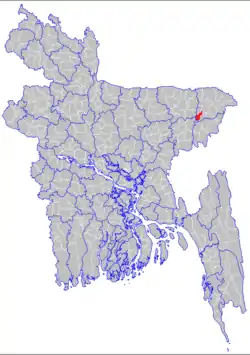Osmani Nagar Upazila
Osmani Nagar (Bengali: ওসমানীনগর) is an upazila of Sylhet District in the Division of Sylhet, Bangladesh.
Osmani Nagar
ওসমানীনগর | |
|---|---|
| Osmani Nagar Upazila | |
 | |
| Country | Bangladesh |
| Division | Sylhet Division |
| District | Sylhet District |
| Government | |
| • Upazila Chairman | shamim Ahmed-vp (Bangladesh Awamileague) |
| Demonym(s) | Osmani Nagari, Usmaninogori |
| Time zone | UTC+6 (BST) |
| Website | www |
Etymology
“Osmani Nagar” is a compound of two words, Osmani and nagar (city), which literally means “the city of Osmani”. Osmani Nagar was named in honour of General Muhammad Ataul Gani Osmani, the commander-in-chief of Mukti Bahini during Bangladesh Liberation War in 1971.
History
Osmani Nagar was previously part of historic Aurangapur Pargana. Following the Conquest of Sylhet in 1303, Shah Jalal instructed his disciples to spread out and propagate Islam. Five pirs, among whom Shah Gabru is most well-known, set up a hujra south of Banaiya Haor in a Hindu village. Many Hindu families embraced Islam due to their efforts and Gabru eventually married into one of the families and the village was named after him as Gabhurteki.[1] Other disciples of Shah Jalal that contributed to the spread of Islam in present-day Osmani Nagar include Nizamuddin Osmani in Dayamir, Shah Sulayman Karani Qurayshi in Karanshi and Shah Jalaluddin in Khushkipur (Korua). The tombs of Shah Siddiq, Shah Garib and Usman Baghdadi can be found in Osmanpur Union. Similarly, Shah Mustafa also passed by the village of Tilapara (in Mukhtarpur, Burunga Union) with a group of Muslims on the way to Chandrapur (modern-day Moulvibazar). They rested under a large tree near a pond situated in the home of a Hindu family of Brahmins (priests). It was customary for this family to give offerings under the tree everyday for their Devata's satisfaction. According to tradition, the priest and his wife had dreamed of the Devata going away and when the family refused to let it go, they said the truth has come, we have no right to stay. Waking up from the dream, they went towards the tree and saw three respectful men. The Brahmin priest had a friendly discussion with them, and accepted Islam. The news of his conversion spread across the area and many more people converted to Islam on that day. On the evening of Mustafa's departure, he entrusted the new converts to one of his murids (disciples).[2]
Shah Tajuddin, a companion of Shah Kamal Quhafah, migrated to village of Gauharpur after arriving in Sylhet in 1315 CE.[3]
Osmani Nagar thana was established with eight Union Parishads of Balaganj on 23 March 2001. On 2 June 2014, the thana was turned into an upazila.[4][5]
Osmani Nagar is famous for providing fierce fighters during the Bangladesh Liberation War, 1971, with General Osmani being a notable figure.
First Upazilla Nirbhahi Officer: First Upazilla Nirbhahi Officer was Mr. Mohammad Showkat Ali. He joined at Osmaninagar Upazilla as the first Upazilla Nirbhahi Officer on 13 July 2015.
Geography
Osmani Nagar Upazila has a total area of 198.7 square kilometres (76.7 sq mi).[6] It borders Bishwanath and Dakshin Surma upazilas to the north, Balaganj Upazila to the east and south, and Nabiganj and Jagannathpur upazilas, of Habiganj District and Sunamganj District respectively, to the west.[7]
Demographics
According to the 2011 Bangladesh census, the eight union parishads that now make up Osmani Nagar Upazila had 34,286 households and a population of 201,354, none of whom lived in urban areas. 11.4% of the population was under the age of 5. The literacy rate (age 7 and over) was 50.3%, compared to the national average of 51.8%.[8][9]
Administration
Osmani Nagar Upazila is divided into eight union parishads: Burungabazar, Dayamir, Goula Bazar, Osmanpur, Sadipur, Tajpur, Umarpur, and West Poilanpur. The union parishads are subdivided into 129 mauzas and 295 villages.[6]
Education
- Tajpur Degree College
- Goala Bazar Adarsha Mahila College
- Dayamir Degree College
- Osmaninagar Islamic Academy
- Mangal Chandi Nishi Kanta Govt. High School.(M.C.N.K)
- Burunga Iqbal Ahmed High School & College
Notable people
- Mufleh R. Osmany, former Foreign Secretary and diplomat
- Muhammad Ashraf Ali, member of parliament
- Muhammad Ataul Gani Osmani, commander-in-chief of Mukti Bahini
- Shah Azizur Rahman, politician
- Shah Gabru, early disciple of Shah Jalal who took part in the 14th-century Conquest of Sylhet
- Shah Tajuddin, late disciple of Shah Jalal
References
- Saqlayen, Golam (1962). Purbo Pakistaner Sufi Sadhok. Bangla Academy. pp. 22–23.
- Ahmad Babu, Syed Kamal. শিকড়ের সন্ধানে (in Bengali).
- Qurashi, Ishfaq. "তিন'শ ষাট আউলিয়ার বিবরণ" [Description of the three hundred and sixty saints]. শাহজালাল(রঃ) এবং শাহদাউদ কুরায়শী(রঃ) [Shahjalal and Shah Dawud Qurayshi (R)] (in Bengali).
- "Two new upazilas to start activities". Dhaka Tribune. 11 June 2014.
- নতুন দুই উপজেলার অনুমোদন [Approval of two new upazilas]. Daily Jugantor (in Bengali). 2 June 2014.
- ইউনিয়ন সমূহ [Unions]. Osmani Nagar Upazila (in Bengali). Archived from the original on 2019-06-11.
- "Upazila Map: Upazila Osmani Nagar". Local Government Engineering Department.
- "Community Report: Sylhet" (PDF). Population & Housing Census 2011. Bangladesh Bureau of Statistics. pp. 62–69, 372–380, 584–591. Retrieved 15 August 2018.
- "Population and Housing Census 2011: Bangladesh at a Glance" (PDF). Bangladesh Bureau of Statistics. Archived from the original (PDF) on July 28, 2014. Retrieved July 21, 2014.